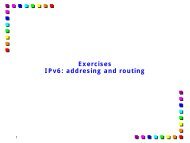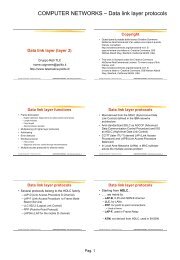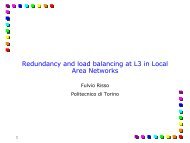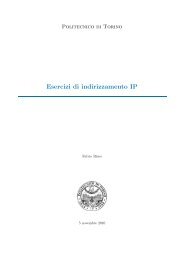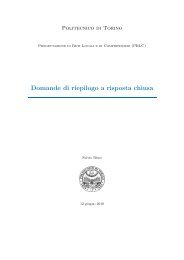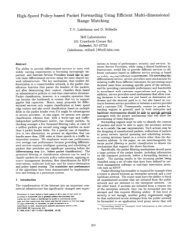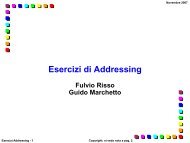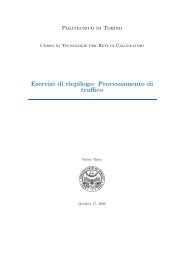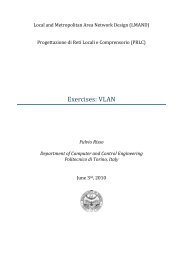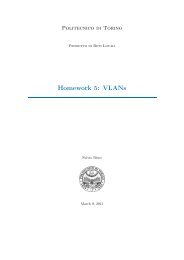Esercizi Routing.pdf - the Netgroup at Politecnico di Torino
Esercizi Routing.pdf - the Netgroup at Politecnico di Torino
Esercizi Routing.pdf - the Netgroup at Politecnico di Torino
You also want an ePaper? Increase the reach of your titles
YUMPU automatically turns print PDFs into web optimized ePapers that Google loves.
DV(R1)<br />
Rete Costo<br />
A 1<br />
B 2<br />
C 3<br />
D 1<br />
E 2<br />
F 3<br />
DV(R3)<br />
Rete Costo<br />
A 2<br />
B 1<br />
C 3<br />
D 3<br />
E 2<br />
F 1<br />
2. R2, ricevendo i nuovi <strong>di</strong>stance vector da R1 e R3 rileva che il costo per la rete C è aument<strong>at</strong>o, e<br />
<strong>di</strong> conseguenza il suo <strong>di</strong>stance vector cambia in:<br />
DV(R2)<br />
Rete Costo<br />
A 1<br />
B 1<br />
C 4<br />
D 2<br />
E 1<br />
F 2<br />
Si verifica chiaramente un fenomeno <strong>di</strong> count to infinity, in cui ad ogni scambio <strong>di</strong> <strong>di</strong>stance vector<br />
aumenta <strong>di</strong> un’unità il costo verso la destinazione C.<br />
4.5.4. Guasto (route poisoning abilit<strong>at</strong>o)<br />
Nel caso in cui il route poisoning sia abilit<strong>at</strong>o, una possibile simulazione della rete dopo il guasto è:<br />
1. R1 e R3 rilevano imme<strong>di</strong><strong>at</strong>amente il guasto; quando inviano i rispettivi <strong>di</strong>stance vector, annunciano<br />
la rete C a costo infinito, poichè è <strong>di</strong>venuta irraggiungibile; inoltre, entrambi da questo<br />
momento in poi utilizzano come next hop R2 per le route che prima erano raggiungibili <strong>at</strong>traverso<br />
il link ora guasto (D e F); i <strong>di</strong>stance vector invi<strong>at</strong>i da R1 e R3 sono pertanto:<br />
DV(R1)<br />
Rete Costo<br />
A 1<br />
B 2<br />
C infinito<br />
D 1<br />
E 2<br />
F 3<br />
DV(R3)<br />
Rete Costo<br />
A 2<br />
B 1<br />
C infinito<br />
D 3<br />
E 2<br />
F 1<br />
2. R2, ricevendo i nuovi <strong>di</strong>stance vector da R1 e R3 rileva che la rete C è <strong>di</strong>vent<strong>at</strong>a irraggiungibile<br />
da entrambe le <strong>di</strong>rezioni, e <strong>di</strong> conseguenza il suo <strong>di</strong>stance vector cambia in:<br />
26



